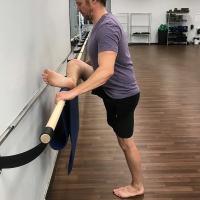
Are you the type of person who does the old ‘run-a-whole-lot-and-stretch-just-a-little’ routine? It's time to break that routine. Here are five basic yoga poses/stretches that every runner should learn to love to keep their tissues healthy. These poses are better for after your run - you don’t want to be wobbling down the road with noodle-y leg muscles.
1. Toe Squat/Shin Stretch
The dreaded toe squat. Getting your body into a kneeling position can be a tough proposition for some folks, that’s your plantar fascia talking. If you’ve ever encountered plantar fasciitis, that awful throb in your arches involves these very same tissues becoming irritated, so keeping them limber is key to healthy running feet. Try to get all ten of your little toes tucked under, then switch with the tops of your feet on the ground to target the muscles in your shins, too. These poses get the most work done when you hang out with them for a while— that means staying down there for one to two minutes.


2. Cross-Legged Forward Fold
If you run often, you know that your hamstrings tend to get a little cranky. To do this pose, simply cross your legs and slowly crawl your hands down your legs until your hamstrings say ‘stop’. This position does limit your stability, so do it on a flat, stable surface preferably near a wall or railing that you can grab onto if you need to. One minute on each leg should do the trick.

3. Soleus/Gastrocnemius Stretch
Most runners' calves light up and get very sore after long runs. This essential sequence of stretches for your calves will keep them from getting locked up. Hold each version of this stretch for at least 30 seconds on each leg, more if you have the time. Fun fact: these muscles are a continuation of those tight tissues from stretch number one, so if either one of them is tight, you will have a very hard time getting into a full-depth squat.


4. Figure 4/Elevated Pigeon Pose
Your hip complex is the key to making sure your whole running setup is in good working order. A traditional pigeon pose can be hard on your knees, so give these variations a try. Keep your ankles dorsiflexed (toes pulling toward shins) and hold the position on each side for one minute.


While we’re talking about knees, I have to air a grievance about “tight knees”. If your knees feel tight, you should stretch your ankles and your hips, not your knees. Your knees typically don’t need much stretching, especially in a pigeon pose stretch position. Overstretching your knees, especially if you feel it on the outer or inner knee joint is probably causing more harm than good. If you feel the stretch more in your knee than your hip, try the version of this pose on your back instead.
5. Revolved Triangle Pose (with block)
The triangle pose is one of the primary Hatha yoga asanas, and this version does an excellent job of targeting that pesky IT band. Using a block or some other raised surface underneath your hand will help you to get a little bit more focus on the outer hip and the lateral thigh. Once again, hold the stretch for a minute or more per side.

Once again, give these stretches a try after your run to minimize soreness and to enhance recovery. As with every other type of exercise, flexibility is equally as important as strength. Happy feet, legs, and hips will make you a happy runner!






